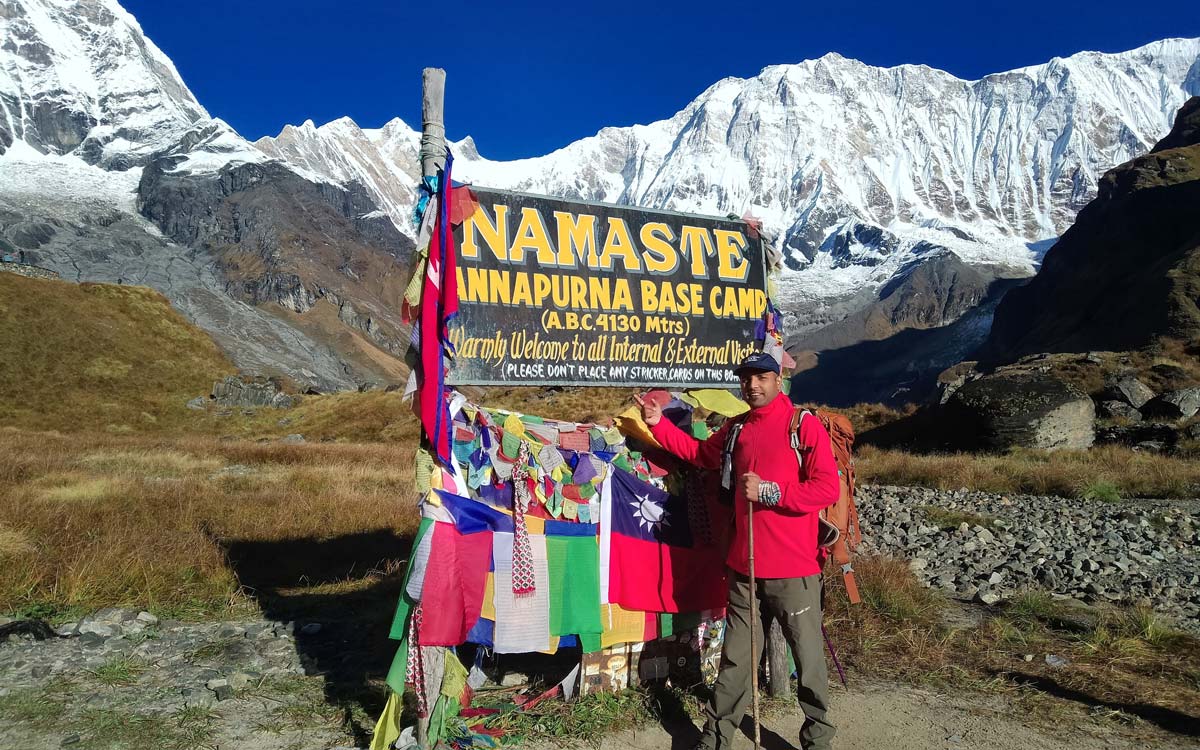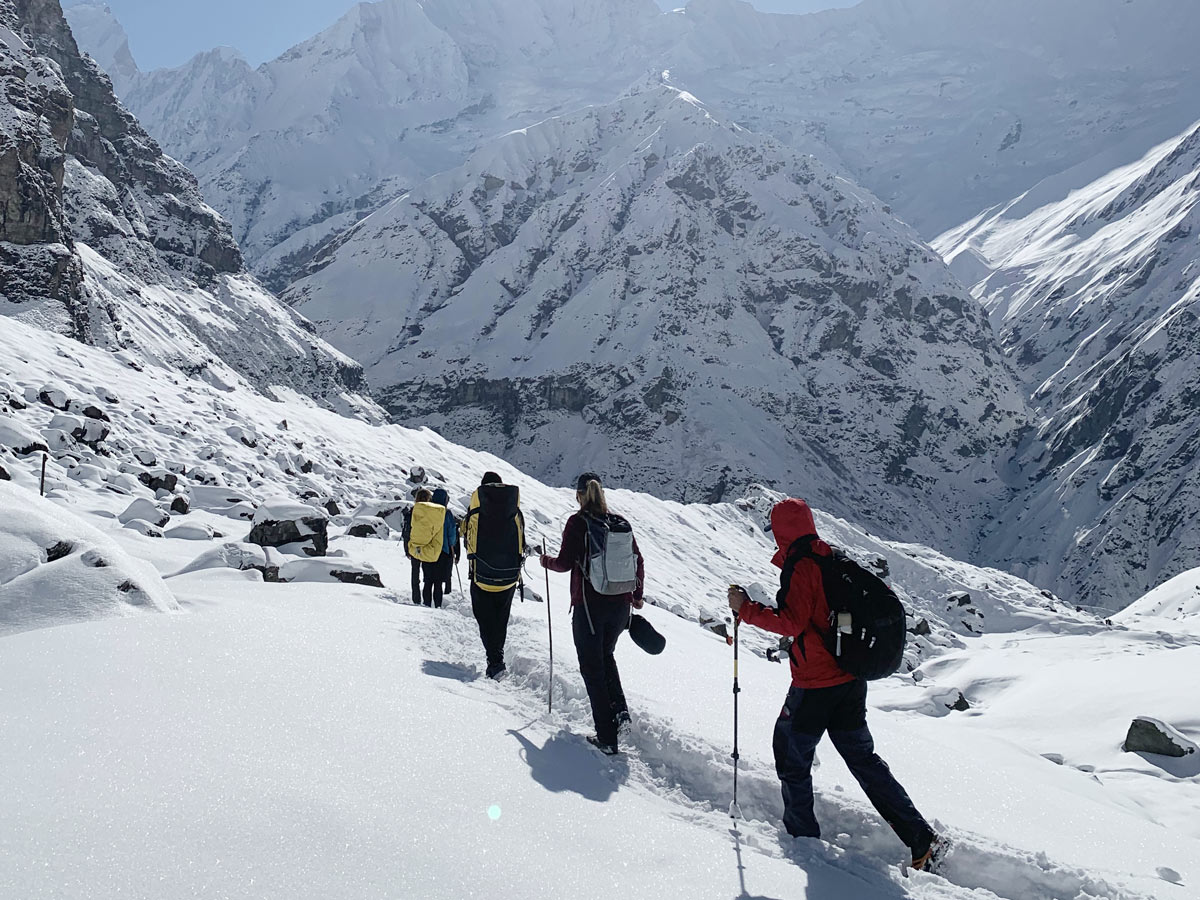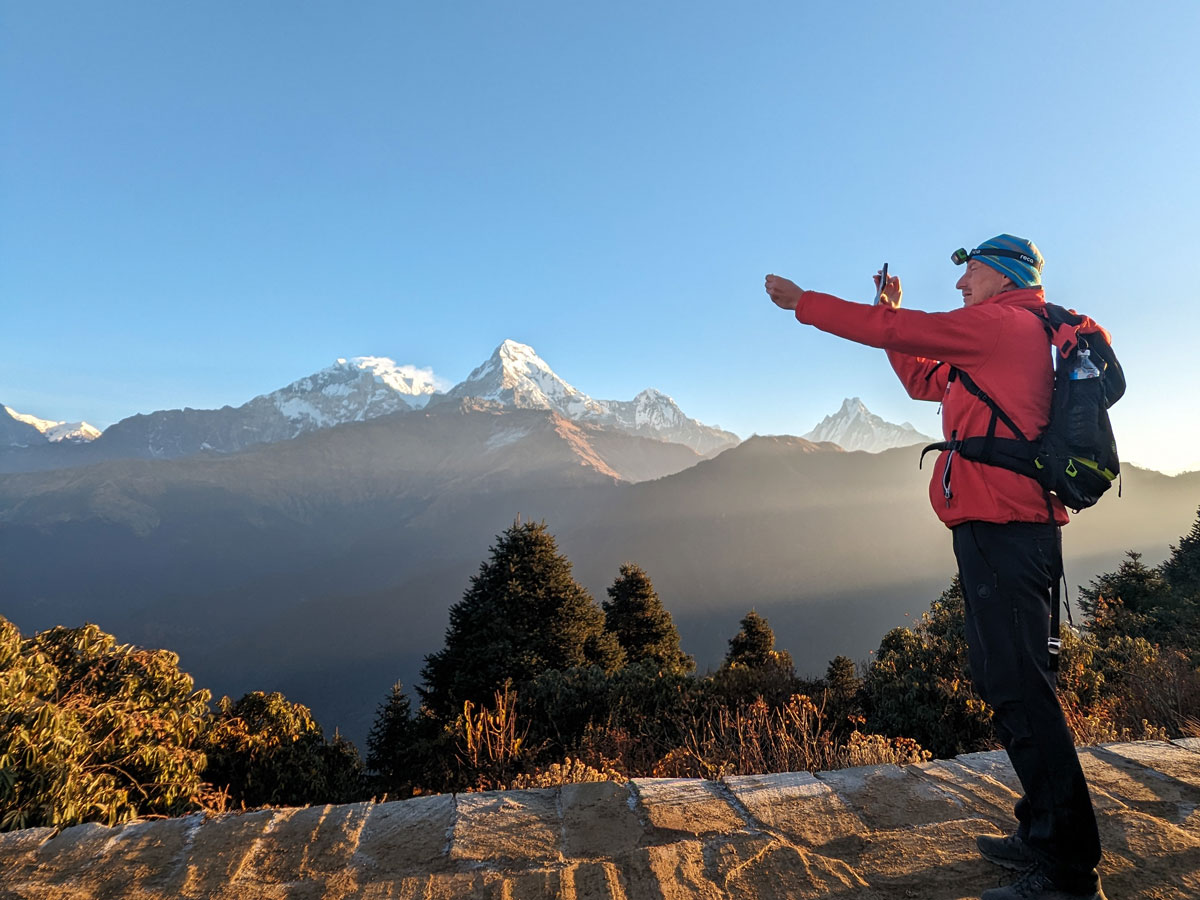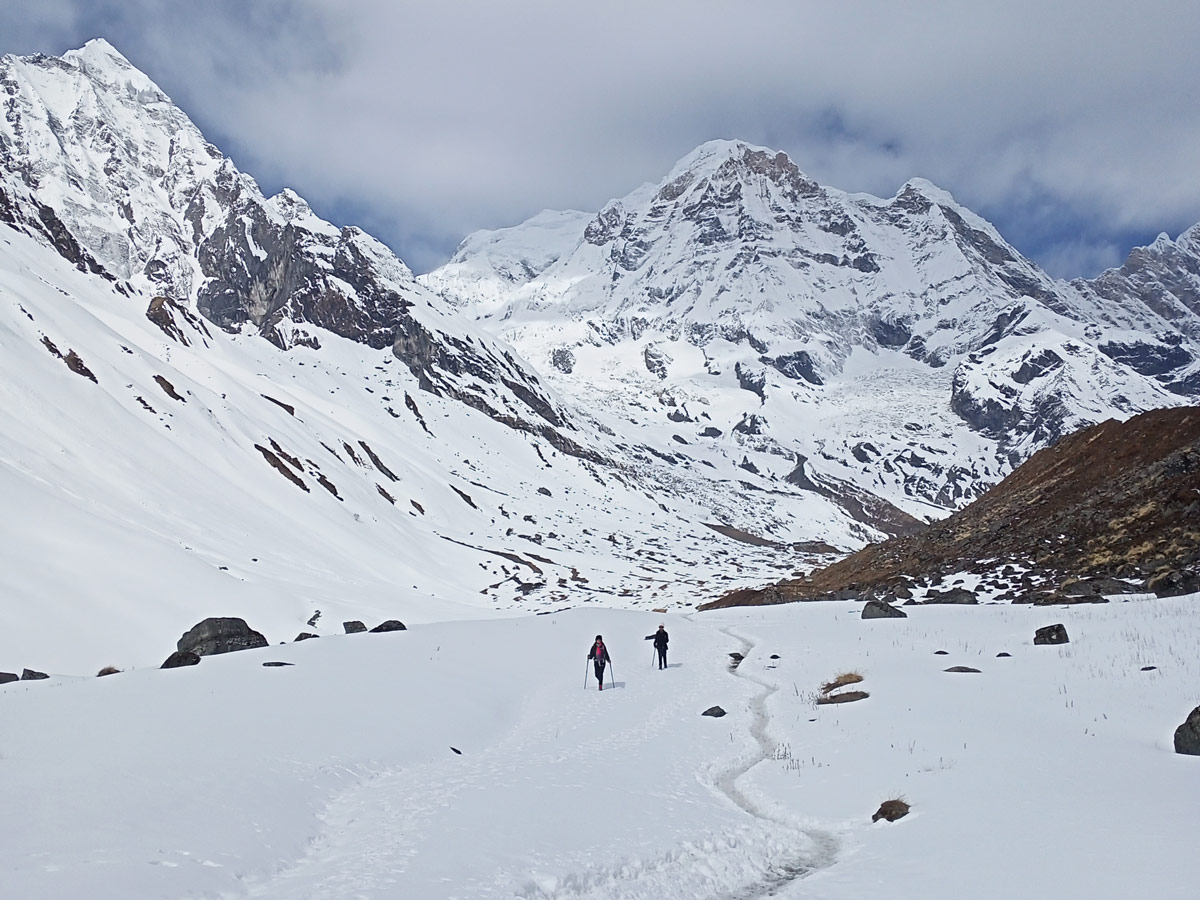The Annapurna Base Camp Trek is undeniably Nepal’s most enchanting and captivating destination for trekkers. ABC is situated among the Himalayan peaks, and it is a true testament to the breathtaking beauty of the region.
The Annapurna terrain is nothing short of stunning, with its diverse landscapes; from lush forests to rugged mountain terrain.
The most awe-inspiring aspect of ABC trek is the exceptional Himalayan scenery that surrounds you at every turn, with the towering Annapurna range.
Beyond the natural wonders, the Annapurna region boasts rich flora and fauna, adding an extra layer of fascination to the journey.
Trekkers are treated to the sight of vibrant rhododendron blooms, exotic wildlife and the melodious calls of countless bird species.
However, it’s crucial to emphasize that when planning a trek to the Annapurna Base Camp, one must give utmost consideration to the weather conditions. Nepal’s mountainous terrain can be unpredictable, and weather conditions can change rapidly.
It is important to select the right season/time for your ABC trek to ensure a safe and thrilling adventure.
The timing of your trek can significantly impact the weather, trail conditions, and the overall atmosphere of your expedition.
In this blog, we will explore the different seasons and their unique characteristics to help you determine the best time to trek Annapurna Base Camp whether you seek vibrant rhododendron, the national flower of Nepal, also known as Laliguras blooms in spring, clear skies in autumn, the challenge of winter, or the lush greenery of monsoon.
Each season offers its own set of advantages and challenges, catering to a variety of trekking preferences
So, let’s embark on this journey to discover the best time for Annapurna Base Camp Trek.
Spring Season (March/April/May/June)
Trekking to the Annapurna Base Camp in the spring season, spanning from March to June, offers an unparalleled adventure in the heart of the Nepalese Himalayas.
Spring season is often hailed as the best time for the Annapurna Base Camp Trek, and for good reason.
During spring, the weather in the Annapurna region is at its most favorable. Days are comfortably warm, allowing trekkers to enjoy the stunning landscapes without the discomfort of extreme cold.
However, it’s essential to be prepared for chilly nights, as temperatures can drop as low as -8 degrees Celsius.
One of the most enchanting aspects of trekking in the spring is the vibrant transformation of the landscape. Lush green forests come to life, and the trail is adorned with the vivid hues of rhododendron and magnolia blooms.
The forested path becomes a tapestry of colors, making it a visual treat for trekkers. However, due to its popularity, the trail can get quite crowded during this season, so it’s advisable to plan accordingly and book accommodations in advance.
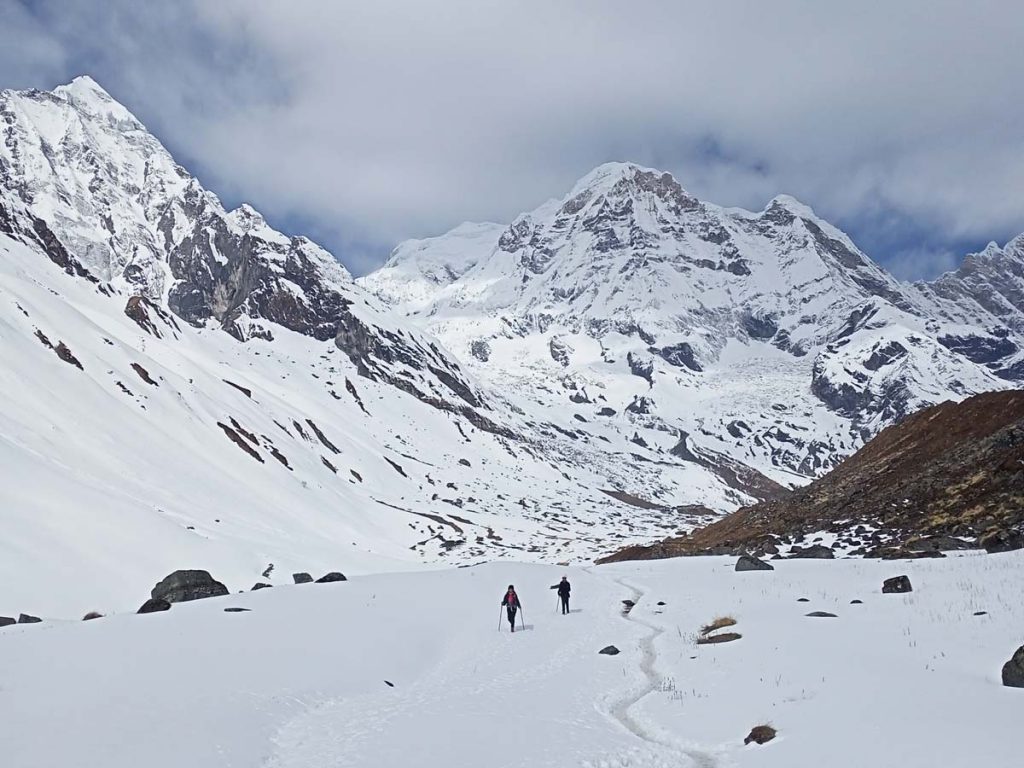
As spring progresses, the snow begins to melt, and the weather becomes milder and more predictable. This makes it the perfect time for Annapurna Base Camp trek without the worry of unexpected snowfall or extreme cold snaps.
It’s crucial to bring appropriate clothing and equipment, including layers to stay warm during chilly nights and protection against the sun during the day.
One of the highlights of this trek is witnessing the magical sunrise views from the Annapurna Base Camp itself.
As the first rays of the sun illuminate the snow-covered peaks, the entire landscape seems to come alive with a warm, golden glow. The experience is nothing short of awe-inspiring and it is memory trekkers cherish forever.
Moreover, as you trek through the region during this season, you’ll have the pleasure of enjoying the melodious chirps of numerous birds and witnessing thousands of butterflies fluttering along the route.
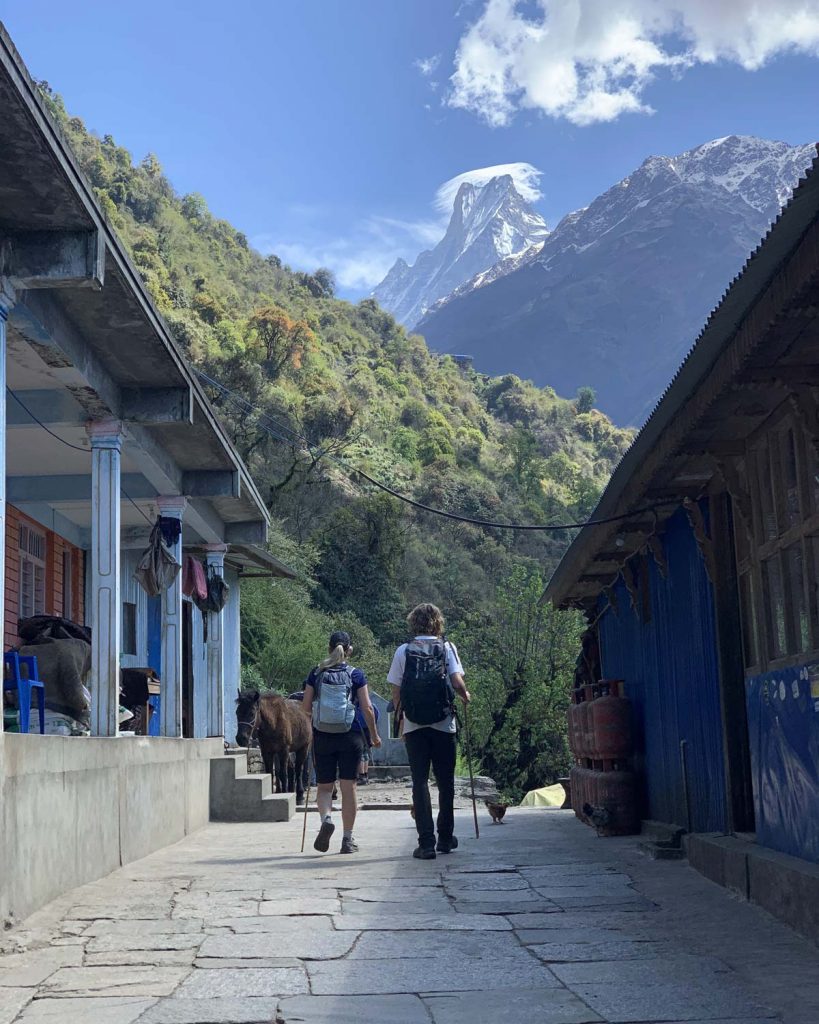
It adds a delightful dimension to the trek, making it not just about the physical challenge but also a sensory journey through nature.
One of the most significant advantages of trekking in spring is that the temperature is neither too hot nor too cold, offering stable weather conditions with relatively low precipitation.
The dry weather ensures that the trails are not slippery, making the trekking experience safer and more enjoyable.
Overall, trekking to the Annapurna Base Camp in the spring season is an unforgettable adventure, where you’ll witness the best of nature’s beauty and experience the Himalayas in all their glory.
Annapurna base camp trek in Summer/Monsoon season (July/August through Mid-September):
Trekking to the Annapurna Base Camp during the summer and monsoon season, which stretches from July through mid-September, presents a distinct adventure in Nepal.
During this time, the weather undergoes a noticeable shift as the country experiences its monsoon and summer seasons.
In the Annapurna Region temperatures during the day typically range between 20 to 25 degrees Celsius, creating a pleasantly warm environment for trekking.
However, nights can get chilly, with temperatures dropping to negative 1-2 degrees Celsius, so trekkers should still be prepared for colder conditions.
The monsoon season in ABC brings with it a unique set of challenges. The most notorious of these challenges are leeches, which thrive in the humid and wet conditions.
Trekkers need to be vigilant and take necessary precautions to prevent leech bites.
To avoid leech bites and tackle the unpredictable weather pack full-length clothes, anti-slippery boots, high quality rain jackets and pants, waterproof clothing as the rain can be intense and frequent.
Carrying a hat with a wide brim serves a dual purpose, offering protection not only from the sun’s relentless rays but also from the rain, keeping your face dry and comfortable throughout your trek.
Additionally, the monsoon season can lead to landslides along some parts of the ABC trekking routes, which can disrupt travel plans and require flexibility and adaptability from trekkers.
One of the remarkable aspects of trekking during the monsoon season is the post-rain mountain vistas. When the rain subsides, and the skies clear, the views of the Annapurna range are breathtaking.
The lush greenery, glistening with raindrops, adds a unique charm to the landscape, and the air feels fresh and rejuvenating.
Trekkers who can embrace the monsoon experience are rewarded with stunning, pristine scenery that is unlike any other time of the year.
Since monsoon is an off-season period, the trails of Annapurna Base Camp are less crowded. It is perfect for individuals who cherish tranquility and solitude.
However, it’s essential to be aware of potential flight delays and cancellations during the monsoon season in Nepal.
The heavy rains and low visibility can disrupt domestic flights to and from the trekking regions, which can pose challenges, especially if you have a tight schedule or connecting flights. It’s advisable to build some buffer time into your travel plans to account for potential delays.
Trekking to the Annapurna Base Camp during the summer and monsoon season is a unique adventure that offers a different perspective on this beautiful region.
While this journey to ABC comes with its own set of challenges, such as leeches and the possibility of landslides, it also provides the opportunity to witness the dramatic beauty of the Himalayas in the aftermath of monsoon rain.
Trekkers who are well-prepared, flexible, and ready to embrace the elements will find this a rewarding and memorable experience.
Annapurna Base Camp Trek in Autumn Season (End of September/October/November)
Trekking to the Annapurna Base Camp in the autumn season, which spans from the end of September through November, is widely regarded as the finest time to embark on this iconic journey.
This season represents the pre-winter period in Nepal and offers some of the most favorable weather conditions for trekking.
The allure of autumn lies in its moderate temperatures, with pleasantly warm days and cool mornings and evenings, creating an ideal climate for outdoor adventures.
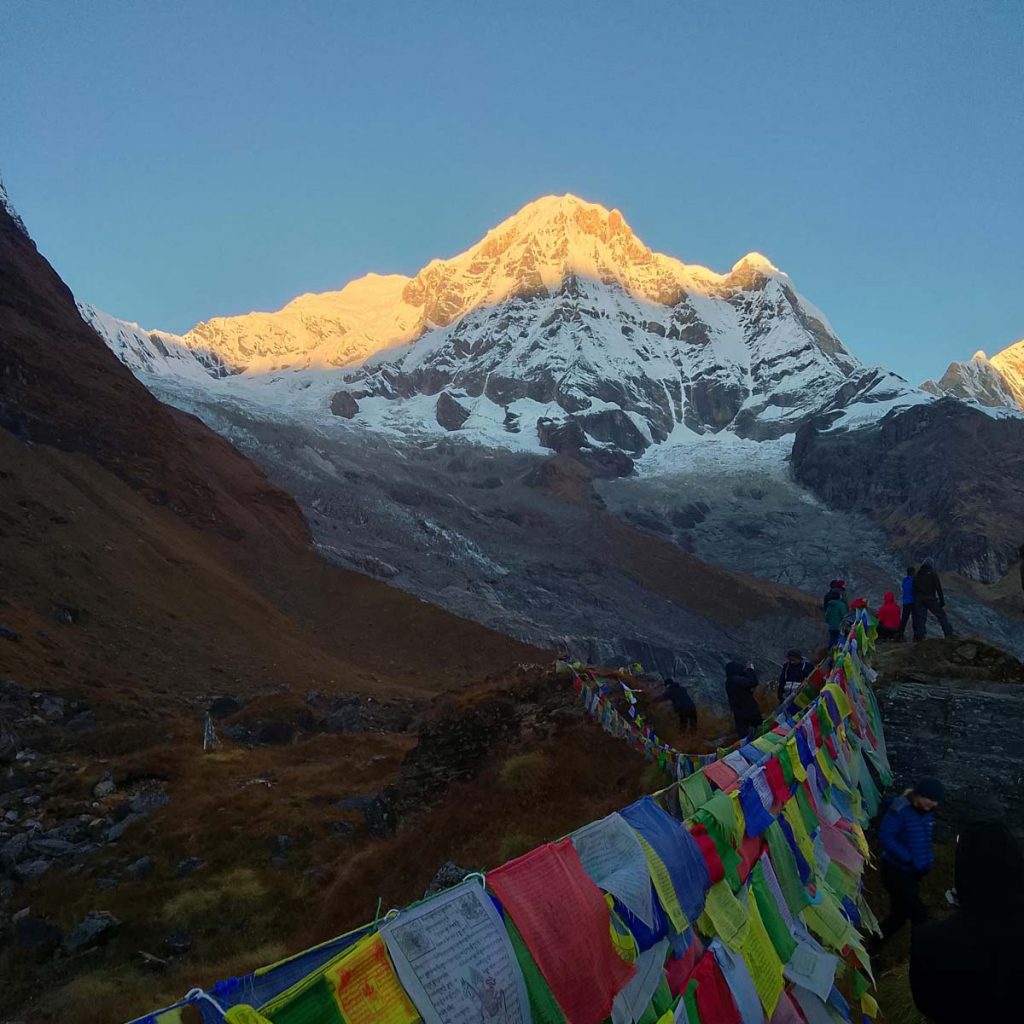
One of the standout features of trekking during the autumn season is the remarkably clear and precise weather.
Thanks to the heavy monsoon rains that precede autumn, the atmosphere is clean and crisp, providing trekkers with unparalleled visibility and allowing them to fully immerse themselves in the breathtaking vistas of the Annapurna range.
As you ascend towards Annapurna, the trail is lined with the delightful fragrances of numerous blooming flowers, adding a sensory dimension to the journey.
The average daytime temperatures during autumn range from a comfortable 12 to 20 degrees Celsius, making it perfect for trekking without the discomfort of extreme cold or scorching heat.
However, it’s advisable to be prepared for chillier nights, as temperatures can drop to an average of negative 3-4 degrees Celsius.
Autumn in Nepal is also the harvest season. As the trails wind through terraced fields and rural landscapes, trekkers can observe the agricultural practices and rural way of life of the local communities of Nepal.
The trekking trails to the Annapurna Base Camp tend to be crowded. While this may pose some challenges in terms of finding accommodations at Tea Houses and sharing the trails, it can also be an enjoyable aspect for those who relish meeting fellow trekkers from around the world.
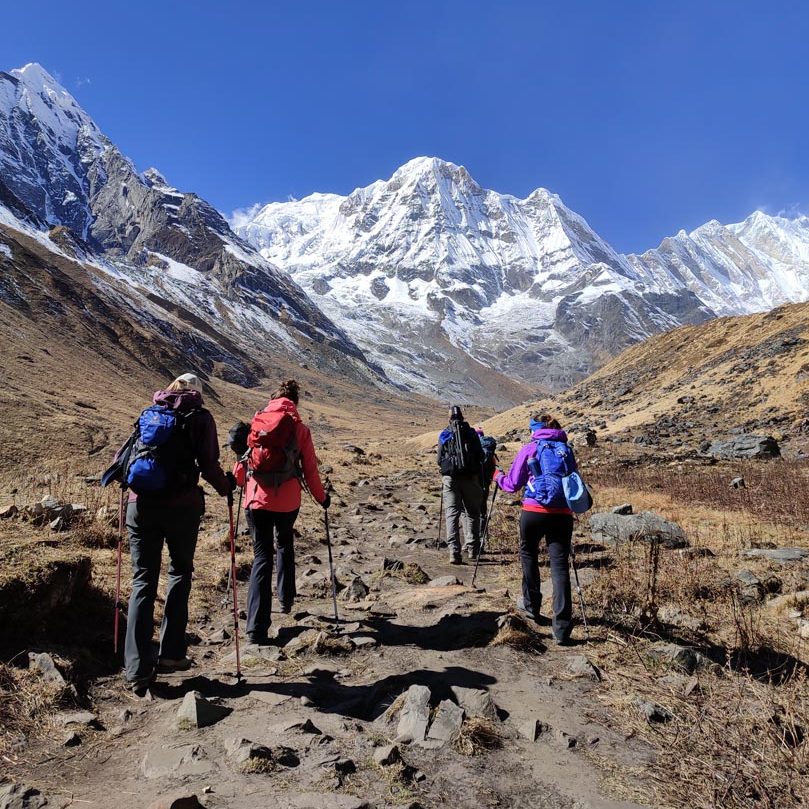
The lively teahouses along the route become hubs of social interaction, fostering a sense of camaraderie among adventurers.
Additionally, the autumn months in Nepal coincide with the significant Nepalese festivals of Dashain and Tihar. It’s an excellent opportunity for trekkers to engage with the local culture, join in the festivities, and gain a deeper understanding of the rich cultures and traditions that define Nepal.
In conclusion, trekking to the Annapurna Base Camp during the autumn season is a remarkable experience that combines ideal weather conditions, stunning vistas, and a vibrant cultural atmosphere.
The crisp, clear skies, comfortable temperatures, and the fragrance of blooming flowers make it an unforgettable journey for trekkers, while the lively trail interactions provide ample opportunities for cultural exchange and making new friends.
It’s no wonder that autumn is the ideal season for Annapurna Base Camp trek.
Trekking to Annapurna base camp in Winter Season (December/January/February)
Trekking to the Annapurna Base Camp during the winter season, which encompasses December, January, and February, is undeniably the most adventurous and challenging option for those seeking to conquer this iconic trail.
The winter season transforms the ABC trek into an expedition marked by extreme weather conditions and a stark, snow-covered landscape.
One of the advantages of trekking during this time, however, is the significant reduction in the number of fellow trekkers, creating a sense of solitude amidst the rugged beauty of the Himalayas.
Winter temperatures in the Annapurna region are unforgiving, with daytime readings ranging from a bone-chilling 0 to 5 degrees Celsius, plummeting to a frigid negative 10-15 degrees Celsius at night. This extreme cold pose significant challenges to trekkers, as staying warm becomes paramount.
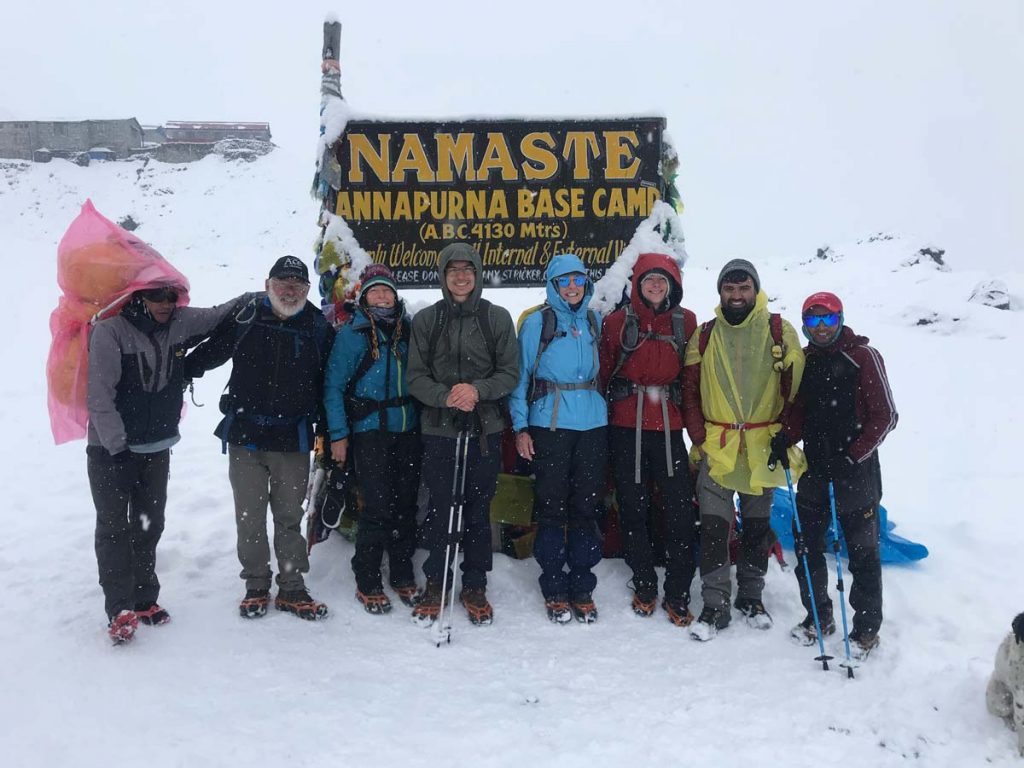
Heavy snowfall blankets the trails, and the risk of avalanches becomes more pronounced, making trekking during this season inherently risky.
Consequently, it is crucial to acknowledge that winter trekking to the ABC is not recommended for novice or inexperienced hikers.
Despite the challenges, the winter season offers a unique and ethereal beauty. The landscape is transformed into a pristine wonderland, with magnificent glaciers, snow-covered peaks, and the possibility of encountering snow animals and flora adapted to the cold.
To tackle the harsh conditions, trekkers will require heavier clothing, including warm woolen coats that provide insulation from the biting cold.
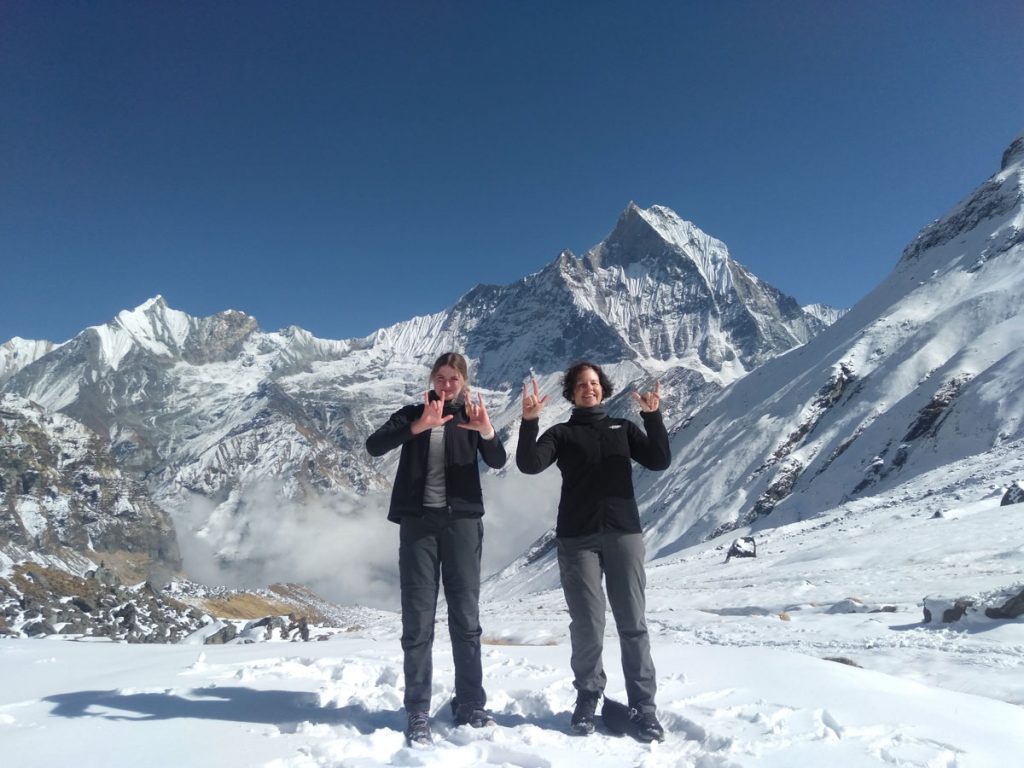
It’s important to note that heavy snowfall and the threat of avalanches can sometimes obstruct hiking trails, making travel both difficult and potentially dangerous for hikers.
Therefore, a thorough assessment of the challenges and potential risks is essential before embarking on the Annapurna Base Camp Trek during the winter season.
Additionally, staying hydrated is crucial to ensure your body functions properly in the cold, and caution is a must to prevent slipping and suffering significant injuries.
Trekking to the Annapurna Base Camp during the winter season is not for the faint of heart. It presents an adventurous and demanding journey that should only be undertaken by experienced trekkers who are well-prepared for the extreme weather conditions and potential hazards that come with the territory.
While the winter landscape offers a unique and awe-inspiring beauty, it is essential to prioritize safety and be fully aware of the inherent challenges and risks associated with this season.
Is Spring the best time for ABC trek?
Yes, Spring is an excellent time for the ABC (Annapurna Base Camp) trek. During this season, the days are warm, the weather is very favorable with clear skies, and the temperature is neither too hot nor too cold, making it comfortable for hiking.
Additionally, the weather is dry, so the trails are not slippery, enhancing the overall trekking experience.
Can I trek Annapurna base camp during Monsoon?
Yes, you can trek to Annapurna Base Camp during the monsoon season, but it comes with a unique set of challenges.
The upside to trekking in monsoon season is that it is less crowded, but you should be prepared for potential landslides, humid and wet conditions, flight delays, and low visibility due to heavy rain and clouds.
Proper planning and caution are essential if you choose to trek during this time.
What is the best season to trek Annapurna Base Camp?
The best seasons to trek to Annapurna Base Camp are Spring (March, April, May, June) and Autumn (end of September, October, November).
During Spring, you can enjoy clear skies, comfortable temperatures, and blooming rhododendrons.
In Autumn, the weather remains stable with clear views and pleasant temperatures. These periods offer the most fine and favorable conditions.
Ultimately, the best time for your Annapurna Base Camp trek depends on your interests, experience level, and willingness to embrace the unique attributes of each season.
Regardless of when you choose to go, careful planning, adequate preparation, and a deep appreciation for the stunning beauty and culture of the region will ensure a memorable and rewarding adventure.
